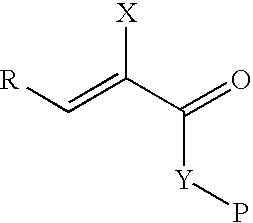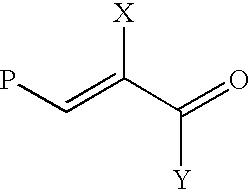Synthetic biomaterials having incorporated therein bioactive factors through enzymatically degradable linkages
a bioactive factor and synthetic biomaterial technology, applied in the field of synthetic biomaterials, can solve the problems of inability to adapt to the body, the linkage mechanism of bioactive factors to synthetic precursor components or synthetic biomaterials, and the disadvantages of the resulting biomaterial described in the prior art, and achieves the effect of reducing the number of enzymatically degradable linkages
- Summary
- Abstract
- Description
- Claims
- Application Information
AI Technical Summary
Benefits of technology
Problems solved by technology
Method used
Image
Examples
example 1
[0101] A bifunctional peptide linker molecule, Pep I, containing a Lys and Cys, (with a primary structure of Ac-FKGG-GPQGIWGQ-ERCG (SEQ ID NO: 17); where the sequence in the middle represents a degradable sequence), was conjugated to the vinylsulfone end-groups of an 8-arm end-functionalized polyethylene glycol (PEG)-macromer to form a precursor component. This peptide linker-modified precursor PEG component served as the amine component for the subsequent cross-linking of TG-plPTH and TG-pl-PDGF (TG sequence: NQEQVSPL; SEQ ID NO: 4) to form PEGylated bioactive factors.
[0102] 1. Coupling of PepI to 8arm-PEG-VS via Michael-type addition. PepI was added to 8arm-PEG-VS in 1.2-fold molar excess over vinylsulfone groups in 0.3 M triethanolamine (pH 8.0) at 37° C. for 2 hours. The reaction solution was subsequently dialysed (Slide-A-Lyzer® 7K, MWCO: 7000, PIERCE, Rockford, Ill.) against ultrapure water for three days at 4° C. After dialysis the product (termed herein 8PEG-PepI) was lyoph...
example 2
[0119] Two linker molecules, mercaptoethylamine (MEA) and a peptide with the primary sequence AcFKGGERCG (Pep II) (SEQ ID NO: 18), were conjugated to a four arm, endfunctionalized polyethylene glycol tetraacrylate (15 kDa) in a first step to form two precursor components. In a second step, the mercaptoethylamine or peptide modified precursor PEG component was conjugated to a TGplPTH 1-34 (NQEQVSPLYKNR-PTH1-34) (SEQ ID NO: 19) and TGplPDGF.AB (MNQEQVSPLPVELPLIKMPH-PDGF.AB) (SEQ ID NO: 20 to form PEGylated bioactive factors. The conjugation was visualized by silver staining of SDS-PAGE.
[0120] Next, the PEGylated bioactive factors were reacted with a second precursor component, a 3.4 kDa polyethylene glycol linear endfunctionalized dithiol and 15 kDa polyethylene glycol tetracacrylate to form a 3-dimensional hydrogel matrix containing the covalently linked bioactive factors. Then, the release of the bioactive factor from the PEG matrices was studied in vitro
[0121] 1. Coupling of MEA ...
PUM
| Property | Measurement | Unit |
|---|---|---|
| Fraction | aaaaa | aaaaa |
| Fraction | aaaaa | aaaaa |
| Fraction | aaaaa | aaaaa |
Abstract
Description
Claims
Application Information
 Login to View More
Login to View More - R&D
- Intellectual Property
- Life Sciences
- Materials
- Tech Scout
- Unparalleled Data Quality
- Higher Quality Content
- 60% Fewer Hallucinations
Browse by: Latest US Patents, China's latest patents, Technical Efficacy Thesaurus, Application Domain, Technology Topic, Popular Technical Reports.
© 2025 PatSnap. All rights reserved.Legal|Privacy policy|Modern Slavery Act Transparency Statement|Sitemap|About US| Contact US: help@patsnap.com



